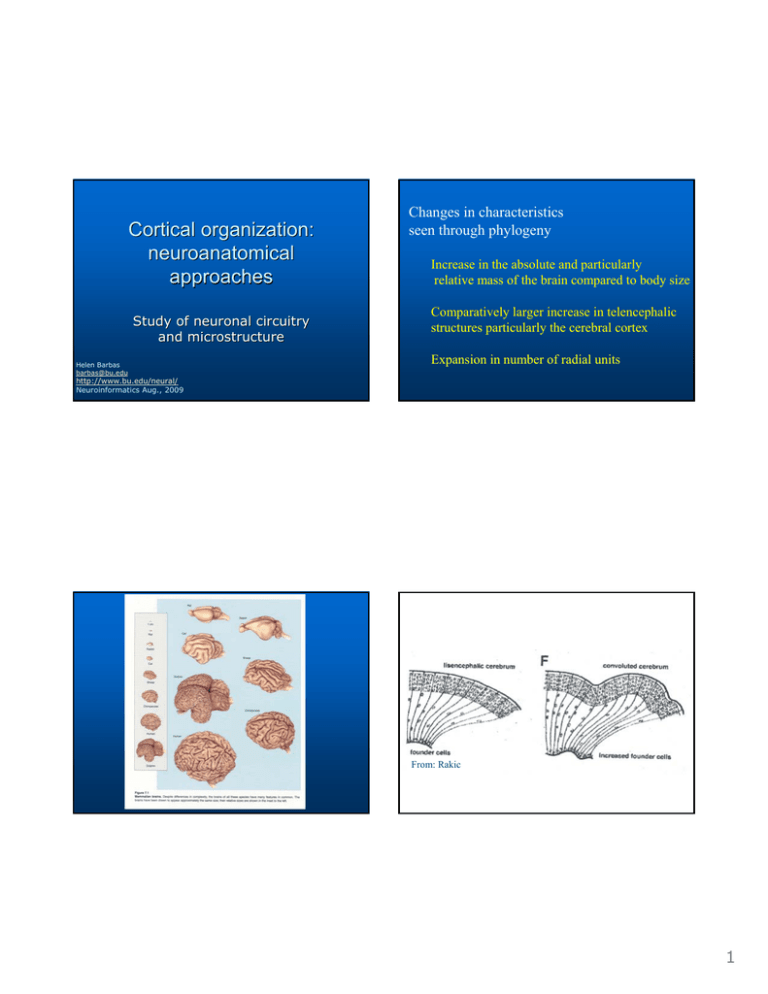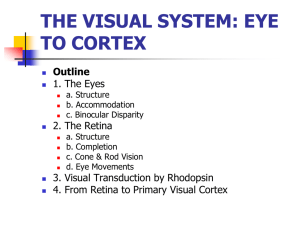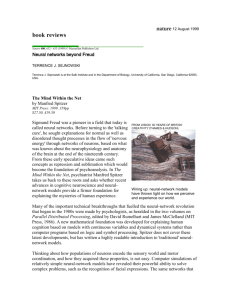Cortical organization: neuroanatomical approaches Changes in characteristics
advertisement

Cortical organization: neuroanatomical approaches Study of neuronal circuitry and microstructure Helen Barbas barbas@bu.edu Changes in characteristics seen through phylogeny Increase in the absolute and particularly relative mass of the brain compared to body size Comparatively larger increase in telencephalic structures particularly the cerebral cortex Expansion in number of radial units http://www.bu.edu/neural/ Neuroinformatics Aug., 2009 From: Rakic 1 Evolution of the Nervous System Neoteny: prolongation of fetal growth rate into postnatal times results in increase in the size of the human brain How does a larger or reorganized brain come about? Environmental factors Internal factors – change in posture freedom of the hands movement of eyes from a lateral to central position EMERGENCE OF BINOCULAR VISION Crossing at the optic chiasm is complete in animals with small degree of binocular vision FREEDOM OF THE HANDS Direct projection to the pyramidal tract in animals with fine use of the hands 2 Distinct modes of radial migration: How did these changes come about in evolution? By what mechanism? Inside-out: characterizes pattern in mammalian cortex Outside-in: characterizes reptilian cortex Consequences of differential migration: differences in cortical thickness, synaptic interactions Factors contributing to the inside-out pattern reelin (glycoprotein) mice deficient in reelin have inverted cortical lamination cdk5 (cyclin-dependent protein kinase) mice lacking cdk5 or its activator p35 show inverted cortical lamination Differences in the two mutants: in cdk5/p35 mutants the marginal zone and subplate are properly differentiated; in the reeler they are not Addition of new cells to the primate CNS Example from humans Spindle cells in cingulate gyrus GABAergic cells in the dorsal thalamus (DT) 3 Specificity of Evolutionary Changes Large expansion of ‘association’ areas Progressive change from the general to the specific; loss of some connections Structures that are large relative to overall brain size have late birthdays Why? Differentiation of cortical layers Building the Brain Brainstem Thalamus and hypothalamus Ventricles Basal Ganglia Amygdala Hippocampus Pathways From: Nolte, J. and Angevine, J.B. The Human Brain 4 From: Nolte, J. and Angevine, J.B. The Human Brain m: Nolte, J. and Angevine, J.B. The Human Brain MAJOR INFLUENCES ON CORTEX Neurotransmitter- specific projection systems: Cholinergic; Adrenergic; serotonergic; Dopaminergic arise from subcortical structures Thalamus/hypothalamus Specialized projections: Hippocampal formation Amygdala From: Nolte, J. and Angevine, J.B. The Human Brain 5 Methods to study cortical architecture Global structure: classical methods Nissl stain (stains all neurons and glia) myelin stain Nissl stain Layers Myelin stain (dark brown) in the prefrontal cortex Cortical organization: areas and layers 6 Cerebral Cortex: Brodmann map Classical stains: Nissl stain myelin Are these methods useful today? Applications stereological analysis to estimate density or overall number of neurons Myelinogenesis: The method was introduced by Flechsig; it makes use of the fact that different fiber tracts become myelinated at different times in their development. Thus, study of the nervous Selective labeling of classes of neurons Histochemistry system in embryos and in early neonatal life often provides information about the existence and locality of the different fiber Immunohistochemistry tracts. Myelination occurs throughout development, and up to the fifth decade of life, and can be used to show development of pathways, particularly in children and adolescents. 7 SMI-32: labels mostly pyramidal neurons, primarily in layers 2-3, and 5-6 Cortical architecture: organization into: layers, columns, and modules Cortical architecture: modules seen by anterograde labeling 8 MAJOR CORTICAL CELL TYPES: Principal or Projection neurons: Pyramidal: project outside of immediate area to other cortices or to subcortical structures Other shapes (e.g., fusiform) Interneurons: Excitatory: stellate: small local neurons Inhibitory: (many different shapes) From: Ramon-y-Cajal Pyramidal neurons in layer III of prefrontal cortex: rhesus monkey Projection neurons (Betz cells): Motor cortex to pyramidal tract 9 Neurochemical markers selectively label distinct classes of neurons in the brain: Differences in neurochemical classes of inhibitory interneurons Parvalbumin inhibitory neurons Calbindin inhibitory neurons Labeling of inhibitory neurons in the brain e.g., GABA (GAD) Neurochemical classes of inhibitory neurons labeled with the calcium binding proteins: parvalbumin; calbindin; calretinin (label inhibitory neurons in the cortex and amygdala but not in thalamus) Regional distribtution of neurochemical classes of inhibitory neurons PV, CB, and CR in Prefrontal Cortices 14000 PV CB CR Density (neurons/mm3) 12000 10000 Parvalbumin positive neurons predominate in the middle cortical layers; they are basket or chandelier type inhibitory neurons, targeting the proximal dendrite or axon initial segment of other neurons. Calbindin positive neurons predominate in the superficial cortical layers; they are double bouquet type inhibitory neurons, targeting the distal dendrite of other neurons. Methods to study cellular architecture Classical: Single cell structure: Golgi method The Golgi method provides 8000 detailed information on dendritic and 6000 4000 axonal morphology and geometry of 2000 neurons. 0 Orbital Limbic Medial Limbic Eulaminate I Prefrontal Groups Eulaminate II Drawback of method: labeling is random and unpredictable 10 Methods to study cortical architecture Modern: intracellular dye injections provide detailed information on dendritic and axonal morphology and geometry of neurons. What do architectonic methods tell us about cortical organization? Quantitative architecture: patterns revealed from multidimensional analyses A25 A14 A24AR A32 A24AC A13G OPRO OPALL A46DC A8VS A13S A8VG A9 A46DR A11 A46VR A46VC A8DS A10 A12 A8DG A25 A24AR A32 A24AC A13S A13G OPRO OPALL A9 A12 A10 A8DG A8VG A46DR A46DC A11 A8VS A8DS A46VC A46VR A14 0.0 A) 0.1 0.2 0.3 Distances 0.4 0.5 B) Dombrowski et al., 2001 Methods to study connections Classical: Classical: Efferent connections: degenerating axons Anterograde degeneration: After a lesion After a lesion has been produced in animals or humans and axon terminals and the surrounding myelin sufficient time has elapsed for anterograde degeneration to set undergo degeneration and degenerating axons and terminals can be stained selectively. in, the brain can be studied, and degenerated tracts can be localized by one of the following methods: Retrograde degeneration: After a lesion cell bodies that lose their postsynaptic input degenerate: e.g., LGn neurons degenerate after •Methods that stain degenerating axons (Nauta-Gygax, Fink-Heimer, De Olmos): Silver impregnation techniques that stain degenerating axons and pre-terminals (Nauta-Gygax) or terminals (Fink-Heimer, De Olmos). lesion of V1 (in some species). 11 Modern methods to study connections Modern methods of tract tracing: Retrograde tracers: used to study the entire input to an Incorporation of tracers into neurons: Passive and active processes (uptake, transport, etc.). Anterograde, retrograde, and transneuronal transport of the tracers can take place depending on the tracer and methods. •Enzymatic method: When the enzyme horseradish peroxidase (HRP) is injected at the site of termination of nerve fibers, it is taken up by the nerve area injected with a tracer. This method replaced the old retrograde degeneration method, which had significant disadvantages. Some retrograde tracers: fluorescent dyes (e.g., fast blue, diamidino yellow); Fluoro-Gold; Cholera toxin, β subunit Bidirctional tracers: HRP-WGA, showing both anterograde and retrograde labeling terminals and transported retrogradely to the perikaryon where it is visualized by an enzyme histochernical technique as blue or brown granules in the soma and dendrites. •HRP reacts with its substrate, hydrogen peroxide, in the presence of an electron donor (i.e. diamino-benzidine, or tetramethyl benzidine) to yield a brown or blue reaction product, seen by light microscopy; or reacted with osmium tetroxide to yield an electron-dense marker for ultrastructural studies. The HRP marker is widely used for tracing neuroanatomical pathways in the brain. From: Xiao and Barbas, Thal. and Related Systems, 2004. 12 •Modern anterograde tracing (efferent connections) •Autoradiography: A method introduced in the 70s, and based on the principle that radioactive amino acids injected in the vicinity of neurons are taken up by the neurons, incorporated into macromolecules, and transported from the cell body down the axon (anterograde transport) to the axon terminal. •After a finite time following injection, the radioactive amino acid can be demonstrated by autoradiography. By this method, the path of a neural tract can be traced from its origin to its termination. •This method replaced the old ablation-degeneration methods (Nauta, Fink-Heimer, etc). •Some anterograde tracers: 3H amino acids; BDA •Bidirectional tracers •Dextran amines are bidirectional tracers: Introduced in the late 1980s, the method is highly sensitive, and widely used for anterograde and retrograde pathway tracing studies of the nervous system. •Dextran amines can be reliably delivered into the nervous system by iontophoresis or pressure injection and visualized with fluorophores or an avidin-biotinylated HRP (ABC) procedure, followed by a standard or metalenhanced diaminobenzidine (DAB) reaction. 13 BDA (excellent anterograde (brown), but also retrograde tracer); coronal sections from prefrontal cortex. •Trans-synaptic transport Anterograde and retrograde tracers that work in fixed tissue: •Anterograde tracers injected in the eye (e.g., 3H amino acids, HRP-WGA; these dyes work only in this system and were used to show the ocular dominance columns in the Carbocyanines (DiI, DiO, DiA) for tracing studies in fixed brain tissue primary visual cortex (V1) after injection in the eye. •Neurotropic viruses for the study of chains of lilnked Disadvantage: very long periods are required, especially for human tissue. neurons; transsynaptic tracing in the retrograde direction (pseudorabies virus) 14 Combining tract tracing and neurochemical markers can provide information on the microenvironment of the origin or termination of distinct pathways From: Zikopoulos and Barbas, 2007. Interaction of prefrontal pathways with excitatory and inhibitory systems: corticocortical connections Prefrontal cortex Temporal cortex 1 1 2 2 3 3 4 4 ‘forward’ 5 5 6 6 ‘feedback’ The microenvironment of the origin and termination of ‘forward’ and From Barbas, 2006 ‘feedback’ connections is different. From Barbas et al, 2005 15 Prefrontal pathways at the synaptic level: axonal boutons terminating in the middle layers are larger than boutons terminating in layer I of superior temporal auditory association cortex From Germuska et al, Cererbal Cortex, 2006 Corticocortical connections in primates are excitatory; but the prefrontal cortex has a major role in inhibitory control From: Zikopoulos and Barbas, 2007. From: Medalla and Barbas, Neuron, 2009 16 From: Medalla and Barbas, Neuron, 2009 From: Medalla and Barbas, Neuron, 2009 What can pathways tell us about normal function and pathology? From: Medalla and Barbas, Neuron, 2009 17 Pathology in schizophrenia: Perspective from pathways Pathology in schizophrenia The roots of the disease are in development, affecting the delicate balance of neuronal migration, architecture and ultimately connections Pathology in schizophrenia affecting cingulate and interconnected structures Hippocampal formation; the rostral half is affected preferentially in schizophrenia The rostral half of the hippocampal formation is the principal source of projections to the anterior cingulate From: Barbas and Blatt, 1995 18 Pathology in schizophrenia Linking cortical architecture to corticocortical connections The structural model: Predicting the laminar pattern of connections from cortical structure A. Large differences in laminar definition Low The number of pyramidal (excitatory) neurons is reduced in the deep layers of the anterior cingulate cortex (ACC) in schizophrenia B. Moderate differences in laminar definition High Lower Higher 2-3 1-3 2-3 1-3 5-6 4-6 5-6 4-6 Low High Higher Lower 2-3 1-3 2-3 1-3 5-6 4-6 5-6 4-6 (Benes et al., Biol. Psych., 50, 2001). The deep layers of ACC project to the upper layers of dorsolateral prefrontal cortex. I II/I II V/VI Agra nular Eulam inate II Dysgranular Eulamina te I Adapted from: Barbas and Rempel-Clower, 1997 From: Medalla and Barbas, 2009 From: Medalla and Barbas, Neuron, 2009 19








